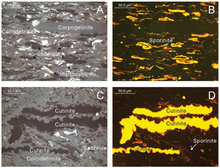User:Chickenchickendinnerwinner/sandbox
Funginite (Maceral)
[edit]Funginite is a maceral that exhibits several different physical properties and characteristics under particular conditions, and its dimensions are based upon its source and place of discovery [1]. Furthermore, it is primarily part of a group of macerals that naturally occur in rocks containing mostly carbon constituents, specifically coal. Due to its nature, research into the chemical structure and formula of funginite is considered limited and lacking [2]. According to Chen et al. referencing ICCP, 2001[3] (International Committee for Coal and Organic Petrology), alongside the maceral secretinite, they "are both macerals of the inertinite group, which is more commonly known as fossilized charcoal, and were previously jointly classified as the maceral sclerotinite"[2]. In the scientific community, the discernment between the two does not remain entirely clear, but there are slight particular and specific differences in regards to the composition between both[2]. It is also the product of fungal development on these carbon rich sedimentary rocks.
Properties
[edit]Funginite's chemical composition is comprised of primarily carbon and hydrogen, and when compared to other macerals in the same group of inertinites, its theoretical carbon to oxygen ratio was discovered to be low in comparison[2]. The maceral was also found to have a low molecular reaction characteristic based on the Arrhenius equation due to its 'A' factor value, also known as its pre-exponential factor, making funginite nonreactive in comparison to other macerals subjected to the same amount of activation energy or kinetic energy in a system[4].
Funginite is primarily found in coal due to the nature of its creation process, which involves a fungal spore or body contaminating resin within trees, and undergoing the heat and pressure process of transformation into coal and other carbon rich substances, which is best summarized as when a "fungus enters a wound in the tree or in the process of rotting the wood or bark can be encapsulated through the release of a resin[5]", which is known as the process of cicatrization[5]. Other methods of fungi being incorporated into resin for the potential formation of funginite may also involve insects or other similar organisms that are carrying the fungal matter to be trapped or even purposefully store said material into the resin, unlike the third main possible method that is a result of the aforementioned fungi in question utilizing the resin as sustenance[5].
Among the other maceral categories, funginite can also be classified under huminite and/or vitrinite. Funginite, along with other macerals that fall in the same family such as cutinite and sporinite, according to one study, exhibits an average reflectance value of 0.81%, with a standard deviation of 0.05. The physical characteristics of the "fungal bodies" not only fluctuate and vary, but also determine the constitution of the spores by causing them to be identified as either single celled or multi-celled by nature[6]. This was done alongside resinite, and the four coal samples had several trials conducted. The results indicated that funginite was "nonfluorescent and [presented] the highest reflectance value"[1], based on a study conducted by the ICCP[3].

Etymology
[edit]
The term "funginite" is based on the word "fungus" that has its roots in Latin, and evolved through to late middle English [7], while its suffix "-ite" pertains to mineralogical nomenclature. There is speculation that it may have also been derived from ancient Greek roots, utilizing the word for "sponge" instead [7].
Discovery
[edit]
According to Hower et al. referencing Jeffrey and Chrysler, 1906[8], Berkeley, 1848[9], and Thomas, 1848[10], fungal constituents and matter are not "new" in the realm of coal and its formation, and the traces of fungal substances in resin, fossilized or not, predates that discovery even further[5]. Currently, funginite, along with other macerals in general, are being researched and identified using micro FTIR (Fourier-transform infrared spectroscopy) mapping, which enables further identification of fluorescence and the organic chemical composition[11].
- ^ a b "Photomicrograph Atlas- Homepage, USGS: Energy Resources Program". energy.usgs.gov. Retrieved 2020-01-23.
- ^ a b c d Chen, Y.; Caro, L. D.; Mastalerz, M.; Schimmelmann, A.; Blandón, A. (2013). "Mapping the chemistry of resinite, funginite and associated vitrinite in coal with micro-FTIR". Journal of Microscopy. 249 (1): 69–81. doi:10.1111/j.1365-2818.2012.03685.x. ISSN 1365-2818.
- ^ a b "The new inertinite classification (ICCP system 1994)". Fuel and Energy Abstracts. 43 (3): 219. 2002-05. doi:10.1016/S0140-6701(02)86016-7.
{{cite journal}}: Check date values in:|date=(help) - ^ "Arrhenius Equation". Chemistry LibreTexts. 2013-10-02. Retrieved 2020-02-05.
- ^ a b c d Hower, James C.; O'Keefe, Jennifer M. K.; Volk, Thomas J.; Watt, Michael A. (2010-07-01). "Funginite–resinite associations in coal". International Journal of Coal Geology. 83 (1): 64–72. doi:10.1016/j.coal.2010.04.003. ISSN 0166-5162.
- ^ "Photomicrograph Atlas". U.S. Geological Survey.
{{cite web}}: CS1 maint: url-status (link) - ^ a b "Fungus | Definition of Fungus by Lexico". Lexico Dictionaries | English. Retrieved 2020-01-23.
- ^ Jeffrey, E.C.; Chrysler, M.A. (1906). "The lignites of Brandon". Fifth Report of the Vermont State Geologist. 6: 195–201 – via www.scopus.com.
- ^ F.L.S, Rev M. J. Berkeley M. A. (1848-12-01). "XXXIX.—On three species of mould detected by Dr. Thomas in the amber of East Prussia". Annals and Magazine of Natural History. 2 (12): 380–383. doi:10.1080/03745485809494736. ISSN 0374-5481.
- ^ Thomas, Dr K. (1848-12-01). "XXXVIII.—On the amber beds of East Prussia". Annals and Magazine of Natural History. 2 (12): 369–380. doi:10.1080/03745485809494735. ISSN 0374-5481.
- ^ Chen, Y.; Caro, L.D.; Mastalerz, M.; Schimmelmann, A.; Blandón, A. (2013-01). "Mapping the chemistry of resinite, funginite and associated vitrinite in coal with micro-FTIR: MAPPING THE CHEMISTRY OF RESINITE, FUNGINITE AND ASSOCIATED VITRINITE". Journal of Microscopy. 249 (1): 69–81. doi:10.1111/j.1365-2818.2012.03685.x.
{{cite journal}}: Check date values in:|date=(help)
